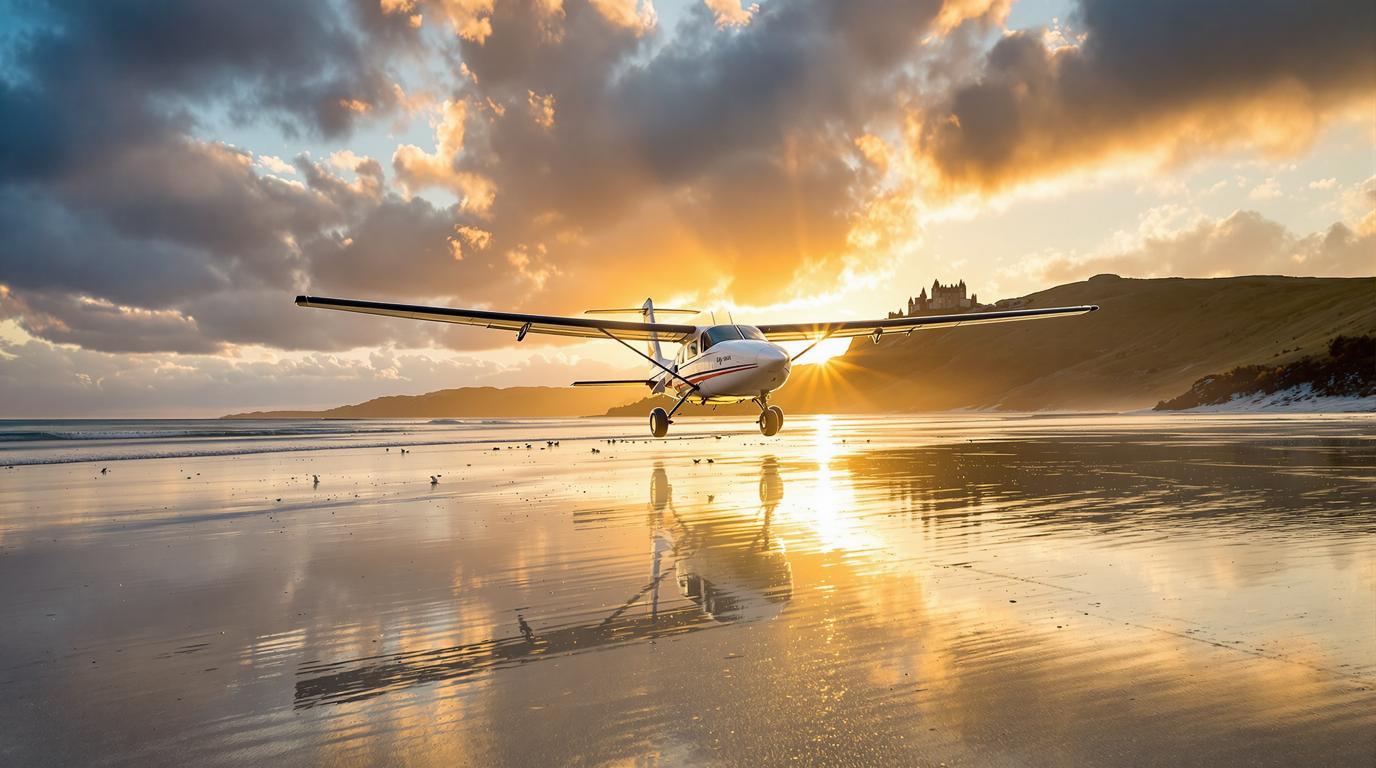Barra’s beach airport might be the world’s only runway where flight schedules depend on the tide. This remote Scottish island in the Outer Hebrides offers travelers a truly extraordinary escape where planes land directly on sand, ancient castles rise from harbor waters, and pristine beaches remain virtually empty even in summer.
Where planes land on beaches and tides dictate arrivals
The moment your Loganair flight approaches Barra’s Cockle Strand is unlike any airport experience on earth. The Twin Otter aircraft descends toward what appears to be just another pristine beach, with the tide determining when landings can safely occur. This is the world’s only commercial airport where scheduled flights use a beach as the runway—a travel experience that alone justifies the journey.
“When the tide comes in, our runway simply disappears,” explains local tour guide Rob MacNeil. “The cockles bubble up during low tide, giving the beach its name, and then the planes can land. It’s been this way since 1936.”
A medieval castle floating in turquoise waters
Kisimul Castle, the 15th-century fortress that guards Castlebay, rises dramatically from a rocky islet in the harbor. This seat of the Clan MacNeil stands as an imposing reminder of the island’s complex history and offers visitors stunning views of Barra’s rugged coastline. For centuries, this stone sentinel has withstood Atlantic storms much like the resilient island community it watches over.
The short boat ride to this medieval treasure provides a perspective of Barra that reminds travelers of floating structures in more tropical destinations, though with distinctly Scottish character.
The machair: Barra’s living carpet of wildflowers
Between May and August, Barra’s western coastline transforms into a spectacular display of natural beauty when the machair blooms. This rare coastal grassland ecosystem, found primarily in Scotland and Ireland, erupts with wildflowers creating a carpet of purple orchids, yellow buttercups, and white daisies.
“The machair is our natural garden,” says Catherine MacNeil, a local crofter. “It’s been cultivated by generations of islanders and supports countless species of birds and insects. There’s nothing like walking through it on a summer evening.”
Authentic island cuisine from ocean to table
Barra’s isolation has preserved culinary traditions that connect directly to its maritime environment. Local restaurants serve lobster and crab caught the same morning, often prepared simply to highlight their exceptional freshness. The community shop Bùth Bharraigh showcases island-made products including seaweed crackers, smoked fish, and unique spirits like rhubarb and heather gin.
This direct connection between food source and table offers a refreshing alternative to the wine-focused gastronomy found in European villages—here, the ocean itself dictates the menu.
Vatersay: The island beyond the island
Connected to Barra by a causeway built in 1991, the island of Vatersay offers even more seclusion and some of the archipelago’s most stunning beaches. The west-facing beach provides sunset views that rival Iceland’s most dramatic natural spectacles, yet remains virtually unknown to most travelers.
With fewer than 90 residents, Vatersay represents the Hebridean experience distilled to its essence—pristine nature, archaeological sites, and a profound sense of peaceful isolation.
Walking among ancient history
Barra’s landscape is dotted with prehistoric remains that have stood for thousands of years. Stone circles, Iron Age brochs, and ancient burial sites emerge from the landscape like natural features. Unlike crowded heritage sites elsewhere, here you can often find yourself completely alone while exploring these ancient monuments.
This connection to the ancient past offers a experience similar to Kenya’s untouched historical landscapes, yet with distinctly Celtic character.
A Polynesian alternative in Scottish waters
While lacking tropical temperatures, Barra’s white sand beaches and turquoise waters create landscapes that appear almost Caribbean when the sun shines. The island’s small population of just over 1,100 residents maintains a distinct cultural identity and warm hospitality that parallels the experience of visiting remote Pacific islands.
On Barra, authentic community life continues alongside tourism, creating an experience that feels genuine rather than manufactured for visitors. The result is a destination that captivates not through polished attractions but through raw natural beauty and cultural authenticity that increasingly rare in our overly connected world.
